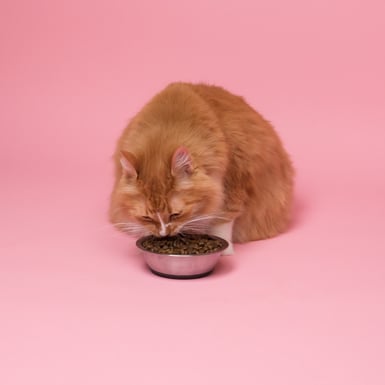The Best Food For Your Cat
Published on: October 28, 2022 | Author: Starwood Pet Travel
 Even if you’re a seasoned pet parent, you may not realize how different cat and dog foods are. Like most of us, you’ve probably never thought about it. However, cats and dogs do have different nutritional needs. And their bodies respond differently to certain ingredients. So it’s not just for marketing purposes that manufacturers offer separate lines of dog and cat food products.
Even if you’re a seasoned pet parent, you may not realize how different cat and dog foods are. Like most of us, you’ve probably never thought about it. However, cats and dogs do have different nutritional needs. And their bodies respond differently to certain ingredients. So it’s not just for marketing purposes that manufacturers offer separate lines of dog and cat food products.
Meeeow! The choices are overwhelming!
Long gone are the days when your biggest challenge was choosing wet or dry. Or which size of food can to purchase. The last thing you want is for your cat to overeat - especially the wrong foods. Today, your cat can eat food that is wet, dry, raw, dehydrated, or made by you from scratch (if you’ll excuse the pun) at home. To some degree, it’s a matter of opinion on what cat food is best, and ultimately it will be up to you and your kitty.
All About Cats conducted an extensive study of cat foods, releasing their findings here. These were among their favorites:
- Smalls Cat Food
- Ziwi Peak Wet Cat Food
- Nulo Freestyle Turkey & Chicken Recipe Gain-Free Canned Cat Food
- Wellness CORE Kitten Turkey & Chicken Liver Recipe Classi Pate
- Dr. Elsey's cleanprotein Chicken Formula Grain-Free Dry Cat Food
- Open Farm Wild-Caught Salmon Dry Cat Food
- Stella & Chewy's Freeze-Dried Raw Absolutely Rabbit Dinner Morsels Cat Food
- Tiki Cat Puka Puka Luau Succulent Chicken
- Cat Person Chicken & Turkey Kibble
- Raised Right
You can immediately eliminate products that contain fillers and potentially harmful ingredients. That includes:
- Dyes
- Artificial colors and flavors
- Preservatives
- Unidentified meat (generic meal, by-products, or “ocean fish”) – these could actually be entrails or other questionable items you wouldn’t eat and your cat shouldn’t, either
- Brewer’s rice
- Carrageenan or carrageenan gum
- Gluten
- Garlic
- Sugar
- Soybeans
It’s enough to give you a hairball. How are you supposed to choose the best food for your cat?
Purrrrrr. Here’s some advice that will make you (and your cat) content.
The right food depends on your cat including details such as:
- Age
- Existing health conditions (i.e. chronic kidney disease or urinary tract problems)
- Weight (more than half of American cats are overweight or obese)
- Propensity to develop hairballs (the right food can cut down on that)
- Allergies or sensitivity to certain foods
As much as your kitty would hate to admit it, she is not a lioness, queen of the wild. She needs plenty of protein, but not a diet of nothing but meat. Along with high-quality protein, she needs fat and carbohydrates. So read the label. Ingredients are listed by weight, in descending order.
- Identified meat or meat meal, or broth should be first. “Identified” means the source is listed - chicken, salmon, etc.
- Fat should be in the top five ingredients. Not rendered fat, because that is a processing plant by-product that could contain bacteria or come from “mystery meat” sources.
- Contrary to the myth, eating some carbohydrates is fine for cats. It can even assist with digestion so they retain more nutrients.
To quickly compare:
- Dry food is the most convenient and usually less expensive, but it’s more processed. Dry food does not improve dental health. Cats don’t chew enough for it to have much effect. (Note that buying in bulk can also save money, but dry pet food doesn’t retain nutrients past 4-6 weeks, even in a sealed container.)
- Canned food is less convenient and more expensive, but it provides vital moisture. Cats tend to drink less water than dogs, but they still need moisture to maintain good health and digestion.
- Raw foods closely mimic a cat’s natural diet but may be harder to digest. Note that grocery store meat is not intended for raw consumption, and the American Animal Hospital Association opposes make-your-own raw foods due to potential contamination concerns.
- Dehydrated foods can be a hassle, but minimize risks associated with raw food. And, again, moisture is an issue.
- Homemade meals require a serious time commitment and may not provide full, balanced nutrition.
You get what you pay for – at least at the lower end. For mid-priced and higher foods, compare ingredients before you compare prices. The most cost-effective solution is a combination of wet and dry cat foods. But remember that most cats are not fond of change. Regardless of your good intentions, suddenly switching their food could trigger an attitude problem as well as digestive problems.
Who knew cat food could be so complex?
But now you do know. Armed with all this information – and with input from your cat's personal veterinarian – you’re prepared to be the health-conscious pet parent you strive to be. Take a break, and have some catnip.
Starwood Animal Transport has rebranded to Starwood Pet Travel. We are still the same great company with the best team, just now with a slightly different name.
Subscribe to the Blog
Enjoy our content? Get them sent to your inbox!
Subscribe Now!


